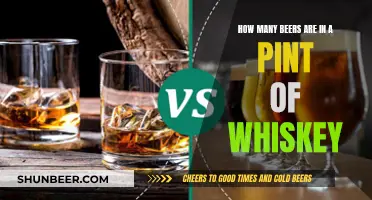
Soju and beer are two very different alcoholic beverages. Soju is a clear and colourless distilled alcoholic beverage, traditionally made from rice, but now also made from other grains such as barley, sweet potatoes, and tapioca. It is often referred to as Korean vodka and has an alcohol content that varies from 12.5% to 53% ABV. Beer, on the other hand, is typically a fermented alcoholic beverage made from barley, wheat, hops, and water. It has a lower alcohol content than soju, typically ranging from 4% to 7% ABV. Soju is usually consumed neat, while beer is typically served chilled. In addition, soju has a sweeter and smoother taste compared to beer, which can have bitter notes due to the presence of hops.
What You'll Learn
- Soju's alcohol content varies from 12.5% to 53% ABV, while beer is typically 4-5% ABV
- Soju is traditionally made from rice, but is now often made from other grains and starches
- Soju is often consumed neat, while beer is usually drunk from a bottle or glass
- Soju is known as Korean vodka due to its smooth, mild, and neutral flavour
- Soju is the most popular alcohol in the world, with Jinro Soju selling 86.3 million cases in 2019

Soju's alcohol content varies from 12.5% to 53% ABV, while beer is typically 4-5% ABV
Soju is a clear and colourless distilled alcoholic beverage, traditionally made from rice but now also from other grains. Its alcohol content varies from 12.5% to 53% ABV, while beer is typically 4-5% ABV. Soju is often referred to as "Korean vodka" and is considered to be smoother and milder than vodka, with about half the alcohol content.
The alcohol content of soju can vary significantly depending on the brand and the method of production. Some soju brands, like Hwayo, offer a range of mixes with ABV levels ranging from 17% to 53%. The average ABV of soju is around 20%, which is higher than beer but lower than spirits like vodka, which typically have an ABV of around 40%.
The ABV of soju has also changed over time due to historical events and government regulations. For example, the South Korean government banned the use of rice in soju production from the 1960s to 1990s due to rice shortages, which resulted in soju being made from ethanol distilled from sweet potatoes and tapioca, reducing the ABV. Since the 1990s, soju producers have been allowed to use rice again, and traditional hand-crafted soju can have an ABV of around 45%.
The varying alcohol content of soju allows for different ways of consumption. Lower ABV soju is often consumed neat, chilled, and from a shot glass, or mixed with beer to create a cocktail called somaek. Premium soju, which has a higher ABV, can be used in stronger cocktails or mixed with soda water as a spritz.
Oklahoma Beer: Unique Taste or Marketing Ploy?
You may want to see also

Soju is traditionally made from rice, but is now often made from other grains and starches
Soju is a clear and colourless distilled alcoholic beverage that is traditionally made from rice. However, it is now often made from other grains and starches, such as barley, sweet potatoes, tapioca, and cassava. The shift from rice to other starches occurred due to several factors, including government policies, rice shortages, and cost considerations.
Historically, soju was crafted from fermented rice, with the distillation process involving boiling filtered, mature rice wine in a cauldron topped with a two-story distilling appliance. This traditional method of soju production dates back to the 13th century when distilling techniques were introduced to the Korean Peninsula during the Mongol invasions of Korea.
In the 1960s, the South Korean government banned the use of rice in soju distillation due to rice shortages. As a result, soju producers turned to alternative starches such as sweet potatoes and tapioca. This change led to the creation of "`green-bottle' soju", which is now the most common type of soju on the market. It is called "green-bottle" soju due to the green 360ml bottles used by manufacturers to associate the drink with cleanliness and freshness.
While rice-based soju is still available and preferred by some for its slightly sweeter taste, the use of other grains and starches has led to variations in the aroma and flavour of soju. The different starches also impact the texture and nuance of the spirit, making it a versatile ingredient in cocktails and mixed drinks.
The shift from rice to other grains and starches has also influenced the cost of soju production. South Korean ethanol producers, for example, have replaced rice with cassava due to significantly lower capital costs. This change has made soju production more economically viable while still producing a popular product.
Stroh's Beer: Unique Characteristics and Distinctions
You may want to see also

Soju is often consumed neat, while beer is usually drunk from a bottle or glass
Soju and beer are consumed quite differently, despite both being alcoholic beverages. Soju is a clear, colourless, distilled alcoholic drink that is often consumed neat, meaning without any mixers, and usually chilled. It is typically served in a shot glass, with drinkers expected to use both hands to accept the drink as a sign of respect. The alcohol content of soju varies from 12.5% to 53% ABV, with lower alcohol soju becoming more popular since 2007.
In contrast, beer is usually drunk from a bottle or a glass and is not typically served in shot glasses. Beer is a fermented alcoholic drink, usually with an alcohol content of 4% to 5%, which is significantly lower than that of soju. Beer is often paired with food, such as fried foods and fatty meats, and is considered a good companion for heavier meals.
The consumption of soju is deeply rooted in Korean traditions and etiquette. The youngest person at the table is responsible for pouring and refilling everyone's glasses, and it is considered rude to pour a drink for yourself. Soju is also an integral part of Korean celebrations and social gatherings, often shared among friends and family.
While soju is traditionally consumed neat, it can also be mixed with other drinks or used as a base spirit in cocktails. A popular way to enjoy soju is by mixing it with beer, creating a drink called "somaek", a portmanteau of the words "soju" and "maekju", the Korean word for beer. This practice combines the two alcoholic beverages, resulting in a unique drinking experience that blends cultural traditions and modern innovations.
Beer vs Lager: What's the Difference?
You may want to see also

Soju is known as Korean vodka due to its smooth, mild, and neutral flavour
Soju is a clear and colourless distilled alcoholic beverage, traditionally made from rice but later from other grains such as barley, sweet potatoes, and tapioca. It is often referred to as "Korean vodka" due to its smooth, mild, and mostly neutral flavour. Soju is usually consumed neat and has an alcohol content that varies from 12.5% to 53% ABV. However, since 2007, low-alcohol soju below 20% has become more popular.
The name "soju" means "burned liquor", with the first syllable "so" referring to the heat of distillation and the second syllable "ju" meaning "alcoholic drink". Soju is traditionally made by distilling alcohol from fermented rice, a process that takes about 15 days. The distillation involves boiling the filtered, mature rice wine in a cauldron topped with a two-story distilling appliance with a pipe.
Soju is known as Korean vodka because, like vodka, it has a smooth and mild flavour. However, soju has about half the alcohol content of vodka, making it more versatile for cocktails. Soju is also often consumed neat, chilled, and from a shot glass, which is another way it differs from vodka, which is typically consumed at room temperature or chilled but not necessarily from a shot glass.
The most common way to drink soju is to mix it with beer to create a drink called "Somaek", which is a portmanteau of the words "soju" and "maekju" (Korean for beer). Soju is also used in cocktails, either as a base spirit or as a substitute for other spirits like vodka or gin. Its subtle flavour and lower ABV allow it to blend well with other ingredients without overpowering them.
Beers Around the Globe: Exploring the Varieties
You may want to see also

Soju is the most popular alcohol in the world, with Jinro Soju selling 86.3 million cases in 2019
Soju is a distilled alcoholic beverage that is clear and colorless, with a flavor similar to vodka. It is traditionally made from rice, but can also be made from other grains or starches such as sweet potatoes and cassava. Soju has an alcohol content that varies from 12.5% to 53% ABV, although lower alcohol versions below 20% ABV have become more popular in recent years.
Soju is often referred to as "Korean vodka" and is considered the most popular alcohol in the world. In 2019, Jinro Soju sold 86.3 million cases, making it the largest-selling branded spirit in the world, surpassing all other liquor brands. This success is attributed to its popularity in Korea, where it is deeply ingrained in the drinking culture and is affordable and readily available.
The origin of soju dates back to the 13th century when distilling techniques were introduced to the Korean Peninsula during the Mongol invasions. Traditionally, most brands of soju are produced in the Andong region, but it is also made in other regions and countries. The name "soju" means "burned liquor," referring to the heat of distillation.
Soju is typically consumed neat and is known for its vaguely sweet and milky flavor. It is commonly served in small green bottles and shared among friends and family during Korean celebrations. The tradition of drinking soju is often passed down from a young age, and it is considered rude to pour a drink for yourself. The youngest person in the group is expected to pour drinks for their elders, using both hands to show respect.
In recent years, soju has also gained popularity in the United States, with bars experimenting with it as a cocktail ingredient and substituting it for vodka or other spirits in classic drinks. The low alcohol content of soju allows it to blend seamlessly with food and enhances the overall drinking experience.
Anheuser-Busch's Wide World of Beers: How Many Varieties?
You may want to see also
Frequently asked questions
Soju is a clear and colourless distilled alcoholic beverage that is traditionally made from rice. It is often referred to as "Korean vodka" and is the most popular alcohol in the world.
Beer is an alcoholic drink typically made from malted barley, hops, yeast, and water. It is produced by brewing and fermenting these ingredients, resulting in a beverage with a lower alcohol content compared to soju.
Soju is distilled from rice or other grains, while beer is produced through brewing and fermentation. Soju typically has a higher alcohol content, ranging from 12.5% to 53% ABV, whereas beer usually falls between 4% to 5% ABV. Soju is often consumed neat, while beer is typically enjoyed as-is or used in mixed drinks.
Yes, soju can be used as a substitute for beer in certain cocktails and mixed drinks. For example, "Somaek" is a popular Korean drink that combines soju and beer. Additionally, soju can be used as a base spirit in cocktails, providing a milder alternative to vodka or other stronger liquors.







